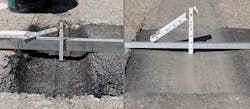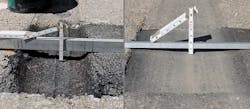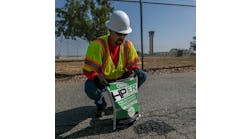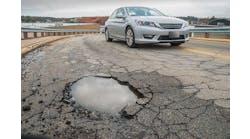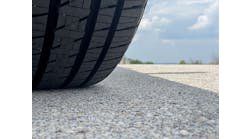By: Ben C. Cox, Webster C. Floyd, John F. Rushing and Craig A. Rutland
Few things frustrate the average motorist more than unrepaired potholes.
They often require drivers to slow down and steer around them or risk damage to the driver’s vehicle; even mild potholes still remain a nuisance to drivers (think spilled coffee on the morning commute). Potholes certainly affect public perception of the state of an agency’s road network. This is reflected by the fact that potholes have increasingly received coverage in the local news—even one of the nation’s major pizza chains is devoting media time to the issue (we’ve all seen the commercials, right?).
Because of these vehicle damage and nuisance factors, many agencies constantly field complaints regarding potholes. Unfortunately from an asphalt materials standpoint, potholes tend to appear more frequently during cold weather seasons when hot-mix asphalt (HMA) cannot be easily obtained because asphalt plants are shut down. Instead, repair crews typically turn to cold-mix asphalt (CMA) for pothole patching. While there are many types of CMA patching materials, ranging from plant-produced cold mix that is stockpiled until needed to small buckets of proprietary cold mixes, CMA simply does not compare to the hot mix that was used to pave the road in the first place. CMA repairs are generally viewed as temporary, and unfortunately, it is usually only a matter of time before the pothole returns.
Now, CMA does not have to be the only answer for winter pothole repairs. Work performed at the U.S. Army Engineer Research and Development Center (ERDC) for the U.S. Air Force (USAF) has developed iHMA, a new inductive hot-mix asphalt material that can be rapidly heated on-site and on demand. This technology offers agencies the ability to easily perform hot-mix repairs even during the construction off-season when plants are not running.
A number of potholes were produced in an existing pavement test section at the outdoor pavements test facility at ERDC; these were saw-cut to approximately 2 ft square and were about 4 in. deep. Patch repairs were performed with iHMA, an HMA control and a CMA control (three replicates for each material).
Defining the problem
Considering iHMA was developed to meet a need for the USAF, it is beneficial to describe the scenarios and problems the USAF faces that are relevant to asphalt patching. Air superiority is a foundation of the U.S. military’s concept of operations; thus, airfield pavements are a critical asset in this strategy. If damaged, quickly restoring the airfield to an operational state is of paramount importance, meaning quality repairs must be performed rapidly, often on demand with little notice, and often in remote locations where HMA is not available.
Additionally, USAF airfield pavements are subjected to the extreme loading conditions of military aircraft including heavy cargo aircraft and fighter jets. For example, the F-15 Eagle fighter jet has a single wheel load over 35,000 lb, but, at 325 psi, its extremely high tire pressure is even more notable. This combination yields a significant contact pressure, and as a result, the F-15E is particularly damaging to asphalt pavements.
Because these airfield patches must be ready for traffic soon after placement and capable of withstanding punishing loads, there are challenges with CMA materials. Most CMA materials utilize cutback asphalt binders to provide workability at ambient temperatures; however, this in turn requires time for solvents to evaporate for the mix to cure and gain stability. Unfortunately for CMA, the tempo of USAF repairs typically does not permit lengthy cure times. In addition to curing issues, CMA gradations are typically not densely graded and are geared towards promoting workability during placement. This factor becomes important under aircraft load.
Over the last decade or so, over 20 different CMA materials, mostly proprietary formulations, have been tested at ERDC for the USAF. The target criteria for an acceptable patching material is to begin trafficking two hours after placement and withstand 100 passes of an F-15E (typically applied using a full-scale vehicle load simulator) with 25 mm (1 in.) or less of total rutting. Under these conditions, a typical proprietary cutback CMA only survives one pass, while newer water-activated proprietary CMAs have survived two to eight passes. In contrast to most reasonable HMA mixes which will meet the rutting criteria, all CMAs evaluated previously fall well short of the 100-pass requirement.
But what about highways and roads that will never face the extreme load of an aircraft? Even for these more conventional pavements, research studies and practice manuals contend that HMA is preferable over CMA in most every scenario, assuming it is available. Because HMA is not available in the construction off-season, CMA is most commonly used. While it is broadly accepted that CMA patching is normally only a temporary solution, it meets the objective of maintaining safety and reasonable ride quality, even if only for a short season. This approach accepts that potholes will most likely need to be re-repaired with HMA once the weather warms.
The additional cost of repeat repair activities has meaningful economic implications. For example, materials costs are typically low relative to other patching-related costs such as labor, equipment and traffic control. Agency surveys and other research have shown that investing in higher-quality materials (like HMA if it is available) on the front end makes economic sense if repeat repairs can be reduced.
In both cases, for either military airfields or civilian road networks, HMA is the ultimate answer for long-lasting patches. The final obstacle standing in the way of widespread HMA use for patching is the inability to obtain it during cold seasons or remote locations. Heating metal buckets of pre-packaged plant mix asphalt in convection ovens is an option, though not a practical one considering several hours are required to heat it to compaction temperatures. To be useful in these situations, the ability to heat asphalt-mix to hot-mix temperatures very quickly is needed.
When damaged, quickly restoring airfield pavements to an operational state is of paramount importance, meaning quality repairs must be performed rapidly, often on demand with little notice, and often in remote locations where HMA is not available.
Innovating a solution
To answer the call for a rapid-heating HMA material, researchers at ERDC set out to develop a mix that could be heated through induction heating instead of standard conduction heating. The objective was to design a material such that a 5-gal bucket could be heated to 300+°F in about five minutes. This material also must satisfy the F-15E rutting requirements used previously. The end result of this research effort is iHMA, a patent-pending inductive HMA material.
Induction heating technology is used in many applications (an induction stove cooktop is likely a familiar example to most individuals). A typical induction system works by alternating current flowing through an induction coil, which creates an electromagnetic field. This field then induces electrical current in any conductive materials located within the coil, generating heat. In order to make use of this technology for asphalt, conductive materials must be incorporated into the asphalt mix, effectively enabling the mix to heat from the “inside out” rather than the “outside in” like most conduction heating.
The goal for incorporating a conductive material was to substitute steel particles for mineral aggregates for heating purposes without negatively impacting the stability that typical crushed aggregates provide a mix. Market research into suitable conductive materials led to the use of different types of steel shot blasting abrasives. These materials were conductive, available in bulk in typical aggregate sizes and shapes, and could be used as a substitute for a portion of mineral aggregate in an asphalt mix. Based on a laboratory evaluation of various steel aggregate materials in the No. 4 to No. 200 fine aggregate size range, two steel aggregate materials were ultimately selected based on their cubical or angular shape.
Varying steel aggregate contents were explored, but a 15% steel content was ultimately used in order to obtain the desired rapid-heating characteristics. In laboratory-scale testing of 1-gal batches, the target temperature of 300°F was achieved with just 3.5 minutes of heating time, and temperatures over 450°F were reached for some steel aggregate combinations. This provided assurance that the iHMA concept could be successful at full scale.
Aside from the ability to rapidly heat iHMA, it was necessary to ensure an integrity mix could be designed including the steel aggregate. iHMA was designed with a dense gradation using 15% steel aggregate and other typical aggregates (e.g., crushed gravel, limestone, coarse sand). A standard Superpave design process was followed that resulted in a 5.0% asphalt content using PG 67-22 binder. For full-scale testing, 5-gal batches were mixed in the laboratory and placed in containers; these prepackaged containers were then ready for full-scale field use.
While material development was taking place, the team also began prototyping an induction heater system for field use. This system consisted of an air cargo logistics container that met transportation requirements for the USAF and housed all the required components. The container could be loaded into a cargo aircraft for long-distance transport or simply placed on a trailer for moving between repair locations. The container housed an induction heater and coil in which a 5-gal bucket of iHMA could be inserted, and it also contained a generator as a power source and a water-cooled heat exchanger to prevent the coil from overheating. The induction coil was entirely enclosed, minimizing safety risks to the operator.
An inductive hot-mix asphalt (iHMA) material turned out to be the solution for a rapid-heating HMA material ERDC researchers set out to develop in order to create long-lasting patches on airfield pavements.
Proofing the concept
The ultimate test for the iHMA concept, both the iHMA mix and the prototype field induction heater, was to validate it at full scale in the field. This was of key importance for the USAF because pavement patching materials must demonstrate the ability to pass the full-scale F-15E load simulator before being certified for live flight operations given the high stakes associated with risking damage to a multimillion-dollar aircraft, not to mention pilot safety concerns. In addition, field testing was conducted in January when air temperatures ranged from 12°F to 32°F (a very cold day for Mississippi). This aspect provided validity to the idea that iHMA could be used in winter when conventional HMA would not be available.
A number of potholes were produced in an existing pavement test section at the outdoor pavements test facility at ERDC; these were saw-cut to approximately 2 ft square and were about 4 in. deep. Repairs were made in two lifts, with each lift being compacted by a vibratory plate compactor. Patch repairs were performed with iHMA, an HMA control and a CMA control (three replicates for each material).
The HMA control material was typical plant-mixed asphalt used in Mississippi and heated to 300°F in metal buckets before use. The CMA control material was a water-activated proprietary cold-mix product. It was placed following manufacturer directions, which included pouring water over the patch to activate the curing reaction.
The iHMA material was heated one bucket at a time in the field induction heater as follows. First, each iHMA bucket was lowered into the induction coil. With everything powered on, the operator selects the duration of heating (five minutes was used in this case) and simply presses the start button. Similar to a household microwave, the heater runs for the set time then turns off, and the bucket is ready for use. iHMA buckets heated with this protocol generally reached around 320°F, demonstrating that the iHMA mixture successfully scaled up from the smaller laboratory tests to reasonable 5-gal batch sizes. iHMA also remained sufficiently hot for some time (e.g., more than 15 minutes) which provides flexibility to the repair crew and also allows multiple containers to be heated and used for a single repair if needed.
Two hours after the repairs were completed, they were trafficked with a full-scale F-15E load vehicle for 100 passes, and rut depths were monitored throughout the process. Results showed that iHMA and conventional HMA exhibited comparable rutting resistance with both accumulating approximately 1 in. of rutting after 100 passes. Both hot mixes significantly outlasted the proprietary cold mix, which exceeded 1 in. of rutting after only eight passes. This trial was considered successful at demonstrating that the iHMA mix could be designed with unconventional steel aggregates while maintaining stability comparable to other conventional HMA mixes.
Overall, the concept of iHMA appears promising. It demonstrated the ability to withstand USAF traffic requirements and has potential for use in other more conventional patching applications such as pothole patching. Relative to CMA or conventional HMA, positive attributes of iHMA in this case include:
- iHMA is pre-packaged and stored in any location for on-demand use;
- iHMA has nearly unlimited shelf life unlike most CMAs;
- iHMA does not need to cure like conventional CMA;
- iHMA can be designed like a conventional HMA (e.g., binder grade, gradation, etc.); and
- iHMA is not limited by ambient temperature or season like conventional HMA.
With proof that this methodology is effective, work is ongoing to continue investigating different mix design possibilities. Efforts also are underway to further evaluate iHMA performance, particularly long-term performance over time. While more sophisticated than the common “throw-and-roll” approach to patching potholes with cold mix, iHMA potentially has application in pavement maintenance organizations, enabling the “fix it right the first time” mentality to be applied in practice.
-------------------------
About the author:
Cox, Floyd, and Rushing are research civil engineers at the U.S. Army Corps of Engineers Engineer Research and Development Center in Vicksburg, Miss. Rutland is a pavements engineer at the U.S. Air Force Civil Engineer Center at Tyndall Air Force Base, Fla. Permission to publish was granted by the Director, Geotechnical and Structures Laboratory, U.S. Army Engineer Research and Development Center.
